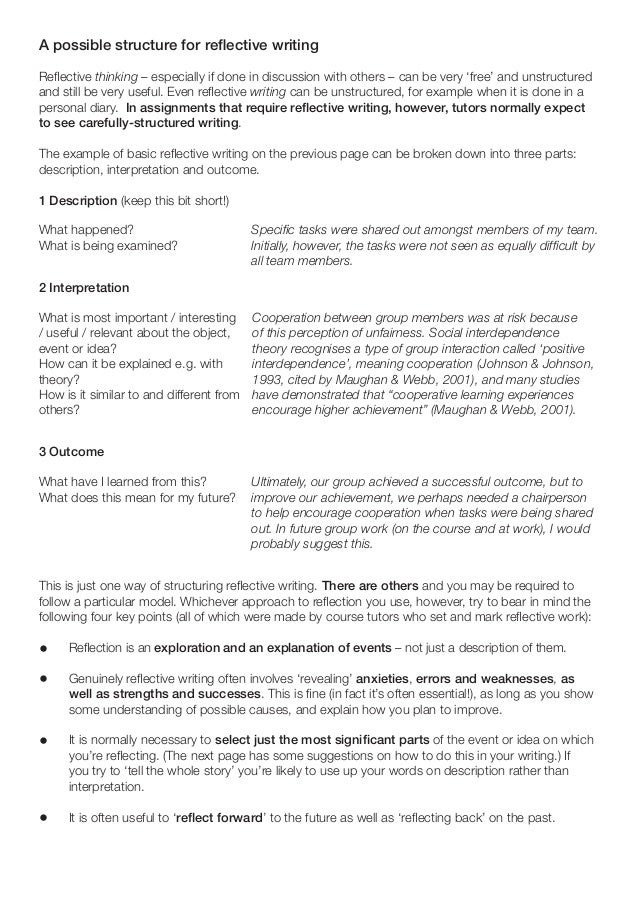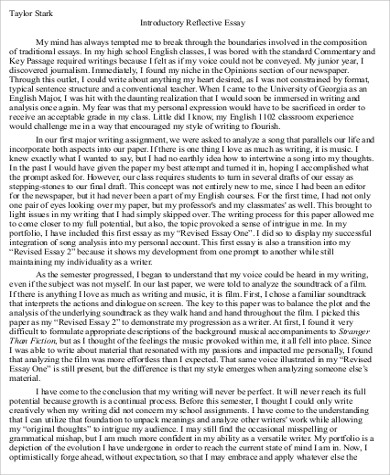
Some examples of reflective writing Social Science fieldwork report (methods section) The field notes were written by hand on lined paper. They consisted of jotted notes and mental triggers (personal notes that would remind me of specific things when it came to writing the notes up) An example of reflective writing. The following example of basic reflective writing can be broken down into three parts: description, interpretation and outcome. First, the full example is provided. Next, it is broken down and divided into the three parts. Full example: “Specific tasks were shared out amongst members of my team. However, the tasks were not · Here are some typical examples of reflective essay formats that you may have to write: A focus on personal growth: A type of reflective essay often used by tutors as a strategy for helping students to learn how to analyse their personal life experiences to
FREE 19+ Reflective Essay Examples & Samples in PDF | Examples
A journal requires you to write weekly entries throughout a semester. May require you to base your reflection on course content. A learning diary is similar to a journal, reflective writing introduction example, but may require group participation. The diary then becomes a place for you to communicate in writing with other group members. A logbook is often used in disciplines based on reflective writing introduction example work, such as science. You note down or 'log' what you have done.
A log gives you an accurate record of a process and helps you reflect on past actions and make better decisions for future actions. A reflective note is often used in law. A reflective note reflective writing introduction example you to think about your personal reaction to a legal issue raised in a course.
An essay diary can take the form of an annotated bibliography where you examine sources of evidence you might include in your essay and a critique where you reflect on your own writing and research processes. a peer review usually involves students showing their work to their peers for feedback. The field notes were written by hand on lined paper. They consisted of jotted notes and mental triggers personal notes that would remind me of specific things when it came to writing the notes up.
I took some direct observational notes recording what I saw where this was relevant to the research questions and, as I was aiming to get a sense of the culture and working environment, I also made researcher inference notes [1] [2].
Not all the information I recorded was relevant but noting what I found informative contributed to my ability to form an overview on re-reading, reflective writing introduction example. However, the reliability of jotted notes alone can be questionable.
For example, the notes were not a direct transcription of what the subjects said but consisted of pertinent or interesting information. Rarely did I have time to transcribe a direct quotation, so relied on my own fairly rapid paraphrasing, which risks changing the meaning. Some technical information was difficult to note down accurately [3].
A tape recorder would have been a better, more accurate reflective writing introduction example. However, one student brought a tape recorder and was asked to switch it off reflective writing introduction example a participant who was uneasy about her comments being directly recorded. It seems that subjects feel differently about being recorded or photographed as opposed to observers taking notesso specific consent should be sought before using these technologies [4].
Question: Discuss at least two things you learnt or discovered — for example about design or working in groups or the physical world — through participating in the Impromptu Design activities. Firstly, the most obvious thing that I discovered was the advantage of working as part of a group [1]. I learned that good teamwork is the key to success in design activities when time reflective writing introduction example resources are limited.
As everyone had their own point of view, many different ideas could be produced, and I found the reflective writing introduction example of group participation made me feel more energetic about contributing something [2]. Secondly I discovered that even the simplest things on earth could be turned into something amazing if we put enough creativity and effort into working on them [1]. With the Impromptu Design activities [3] we used some simple materials such as straws, string, and balloons, but were still able to create some 'cool stuff' [4].
I learned that every design has its weaknesses and strengths and working with a group can help discover what they are. We challenged each other's preconceptions about what would and would not work.
We could also see the reality of the way changing a design actually affected its performance. Last week's lecture presented the idea that science is the most powerful form of evidence [1]. My position as a student studying both physics and law makes this an important issue for me [2] and one I was thinking about while watching the 'The New Inventors' television program last Tuesday [3].
The two 'inventors' an odd name considering that, as Smith says, nobody thinks of things in a vacuum were accompanied by their marketing people. The conversations were quite contrived, but also funny and enlightening. I realised that the marketing people used a certain form of evidence to persuade the viewers us?
of the value of the inventions [4]. To them, this value was determined solely by whether something could be bought or sold—in other words, reflective writing introduction example, whether something was 'marketable', reflective writing introduction example. In contrast, the inventors seemed quite shy and reluctant to use anything more than technical language, almost as if this was the only evidence required — as if no further explanation was needed.
This difference forced me to reflect on the aims of this course—how communication skills are not generic but differ according to time and place. Like in the 'Research Methodology' textbook discussed in the first lecture, these communication skills are the result of a form of triangulation, [5] which I have made into the following diagram:. Brookfield, SDeveloping critical thinkers: challenging adults reflective writing introduction example explore alternative ways of thinking and actingOpen University Press, Milton Keynes.
Mezirow, JFostering critical reflection in adulthood: a guide to transformative and emancipatory learningJossey-Bass, San Francisco, reflective writing introduction example. Prepared by Academic Skills, UNSW. This guide may be distributed or adapted for educational purposes, reflective writing introduction example. Full and proper acknowledgement is required.
Skip to main content. myUNSW Moodle Library Handbook Email. Current Students, reflective writing introduction example. Sign on Search Menu. Student Home Getting Started Accept your offer How to enrol Student ID card Set up your IT Orientation Week. Exams Reflective writing introduction example. The Nucleus: Student Hub.
Psychology Health Service. Accommodation Health services Sport and gym. Moodle myUNSW Email Microsoft Office myLibrary Careers portal Change your password Need help? Student Support Academic Skills Writing skills Essay and assignment writing Reflective writing Print to PDF. Types of reflective writing assignments A journal requires you to write weekly entries throughout a semester. A self-assessment task requires you to comment on your own work.
Some examples of reflective writing Social Science fieldwork report methods section The field notes were written by hand on lined paper. Includes discipline-specific language 3. Critical evaluation of method 4. Conclusion and recommendation based on the writer's experience Engineering Design Report Question: Discuss at least two things you learnt or discovered — for example about design or working in groups or the physical world — through participating in the Impromptu Design activities.
Addresses the assignment question 2. Reflects on direct experiences 3. Direct reference to the course activity 4, reflective writing introduction example. The style is relatively informal, yet still uses full sentences.
Relating what was learnt. Learning Journal weekly reflection Last week's lecture presented the idea that science is the most powerful form of evidence [1].
Like in the 'Research Methodology' textbook discussed in the first lecture, these communication skills are the result of a form of triangulation, reflective writing introduction example, [5] which I have made into the following diagram Description of topic encountered in the course 2. The author's voice is clear 3. Introduces 'everyday' life experience 4.
The style is relatively informal, yet still uses full sentences 5. Makes an explicit link between 'everyday' life and the topic References Brookfield, SDeveloping critical thinkers: challenging adults to explore alternative ways of thinking and actingOpen University Press, Milton Keynes. Schön, DAEducating the reflective practitioner reflective writing introduction example, Jossey-Bass.
San Francisco. We thank the students who permitted us to feature examples of their writing, reflective writing introduction example. Academic Skills Referencing. Essay and assignment writing. Essay and assignment planning.
Answering assignment questions. How do I write reflectively? Engineering and science. Other links and resources. Reading and note-taking. Contacts and appointments. Back to top. Website Feedback Contacts Sitemap A-Z Guide. UNSW Sydney NSW Australia Authorised by Deputy Vice-Chancellor Academic UNSW CRICOS Provider Code: G TEQSA Provider ID: PRV ABN: 57 Page last updated: Friday 19 February Conclusion and recommendation based on the writer's experience.
Makes an explicit link between 'everyday' life and the topic.
Reflective writing
, time: 6:28Reflective Essay Examples

To write an effective and successful reflection, a student must start his paper with an introduction that eases the reader into the topic and briefly states what will be discussed via a thesis statement. Make an outline of your reflection paper. Decide what you want to write about and how many paragraphs the entire paper will be 18 hours ago · How to write a term paper introduction- The Procedure In the same way that knowing how to write a term paper introduction is a process term paper introduction sample requires some time, there are also stages that you have to go through in writing one. Create a scene One of the tasks of an introduction is to set the background for the discussion or paper and put it into a context so that Some examples of reflective writing Social Science fieldwork report (methods section) The field notes were written by hand on lined paper. They consisted of jotted notes and mental triggers (personal notes that would remind me of specific things when it came to writing the notes up)
No comments:
Post a Comment